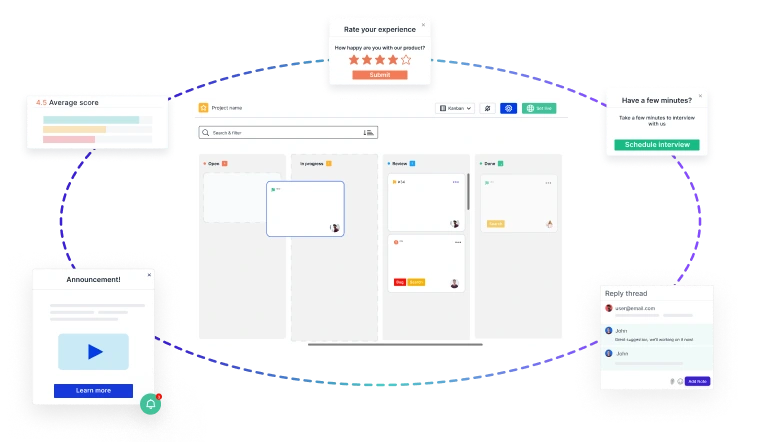Have you heard about Coc Coc browser or YaBrowser? I’m guessing you have not and that would not be a surprise.
I haven’t heard about them either. Just recently, I stumbled upon a list of unknown browsers in our Google Analytics dashboard. And surprisingly, those browsers are responsible for quite a bit of website traffic.
Here’s the journey I undertook after my big discovery.
Developing for a global audience
In our #InsideSaaS series we gave you some insights on how to build a SaaS product for a global audience. Thinking about product translations, time- and culture differences and local user experiences are just the beginning.
We haven’t talked about the topic of browser diversity and how to handle it.
What’s your browser status quo?
First things first.
Let’s check your statistics and take a deeper look at which browsers are being used by your website visitors and users. If you have Google analytics (or any similar analytics tool) installed, it’s pretty easy to find that information.
Looking at our Analytics dashboard, I was quite surprised to find at least 4 desktop browsers I haven’t heard of before right there in the top 15 browsers used by our site visitors.

Oops. Why haven’t I noticed that before.
I got a little troubled. How does our website look like in those browsers? Where are those people coming from? How does their user experience look like?
Those questions started worrying me and I tried to find some answers. And here’s what I did next.
The role of browser diversity and how to be relevant
Knowing your target audience is crucial. And luckily a detailed analysis of our target audience was already conducted before we released a new website.
However, I’m surprised that we forget to think about the tiny little detail of how those people might use our websites and apps.
So, I tried to find some answers on the following question:
- Which devices are being used by our local audiences?
- Which browsers are the most common among our target audiences?
- Which search tools are being used?
In order to answer those question, market research needs to be conducted. So, let’s get started.
Step 1) Define the countries you’d like to target
Providing a global SaaS product, does not necessarily prevent you from thinking about local markets.
Most people define global by having an English product. But I doubt that your English product will be used in the same way across China, Spain and the US.
Step 2) Research browser statistics in your targeted countries
If we take a look at the worldwide browser statistics, we won’t find any big surprises. Chrome is leading in the Desktop browser war, followed by Firefox and Internet Explorer.

(source: gs.statcounter.com)
But let’s assume that we defined Russia as one of our target markets, the browser game looks a bit different. Still, Chrome is leading (with 47%), but did you know that Yandex Browser is used by more than 12% of all desktop browser users in Russia? I did not.
Now let’s take a look at South Africa. Did you know that Opera is the most-used mobile browser in the country? Quite interesting I guess…

Step 3) Browser testing done right
Depending on your defined markets you may simply run browser tests on Chrome, Firefox, Safari, and Edge. This can be done quite easily with existing browser testing tools such as SauceLabs or BrowserStack.
For further info on that, I’d recommend starting here:
But how can you test your site in unusual browsers?
The hard thing about browser testing is finding tools and ways on how to test unusual browser versions.
While conducting my research I found out that while the most popular browser testing tools I know support only the top browser players we know, some do support unusual browsers:
But if you really want to be 100% sure, I recommend setting up a local test environment where you’re running local browser tests in your unusual browsers.
But here comes the good news.
Chromium projects FTW
Chromium is an open-source web browser originated from Google Chrome. Most of these new browsers (also included the mentioned ones) are based on the Chromium project, which make use of the rendering engine.
The good news is that if you want to ensure a bug-free website in those unusual browsers you just need to make sure that it works with the basic Chromium browser. If your site works in Chromium, it is safe to say it will probably render correctly in those unusual ones too.
Wrapping it up.
If you took a look at your analytics account and analyzed the browsers of your users and customers, I’ve done my job here. Raising awareness for the browser diversity is a first step in the right direction.
As developers, designers, and project managers we often tend to underestimate unusual browsers. Optimizing for Chrome and Firefox might be the right thing to do. But in some cases, your target group might be using other browsers too.
So don’t forget them!
What’s the most unusual browser you used?
Accelerate Issue Resolution with Visual Bug Reporting

Identify, capture, and resolve issues faster with screen recordings, screenshots, and contextual feedback—seamlessly integrated into your product development lifecycle.
And if you’re ready to try out a visual bug tracking and feedback solution, Usersnap offers a free trial. Sign up today or book a demo with our feedback specialists.